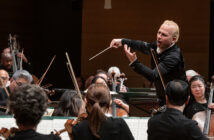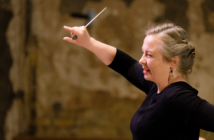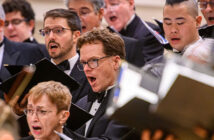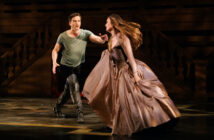
This page is also available in / Cette page est également disponible en:
![]() Francais (French)
Francais (French)
If I look back on what they now call “the roaring Twenties”, it is like looking at a rich tapestry of almost blinding color. So much happened in those years which were marked by abundant prosperity in America and a cultural liveliness which was breathtaking. Music of our time all of a sudden became a matter of interest, and everybody felt like jumping on the bandwagon.
So wrote Canadian mezzo-soprano Eva Gauthier, an artist ideally suited to a period that invariably attracted the sophisticated, the exotic, the adventurous and the new. She had already sung Satie’s music-hall tunes, was familiar with works of Eastern inspiration, and collected the novelties of Europe. In the early 1920s she provoked a heated artistic debate in New York by daring to bring sophisticated jazz into the sanctity of the recital hall, with the assistance of George Gershwin who was making his first appearance on the concert stage. With the momentum and notoriety obtained from this bold move, Eva Gauthier maintained a highly eventful career throughout the 1920s and thereafter was assured of a place in history.
How had this Ottawa-born singer acquired the wherewithal to make a niche for herself in Gotham? As one of Gauthier’s accompanists candidly observed, writing to her from Ottawa while on a concert tour, “I realized that you belong here no more than Tallulah Bankhead, Stravinsky or Benedetto Croce.”So wrote Canadian mezzo-soprano Eva Gauthier, an artist ideally suited to a period that invariably attracted the sophisticated, the exotic, the adventurous and the new. She had already sung Satie’s music-hall tunes, was familiar with works of Eastern inspiration, and collected the novelties of Europe. In the early 1920s she provoked a heated artistic debate in New York by daring to bring sophisticated jazz into the sanctity of the recital hall, with the assistance of George Gershwin who was making his first appearance on the concert stage. With the momentum and notoriety obtained from this bold move, Eva Gauthier maintained a highly eventful career throughout the 1920s and thereafter was assured of a place in history.
Eva Gauthier had actually left her native city in 1902 at the age of 16 to study voice in Paris, London and Milan for seven years under the patronage of Lady Laurier and Lord Strathcona. In London she became the protégé of her compatriot Emma Albani, who engaged Gauthier for this diva’s Farewell Tour of Canada in 1906. Following her operatic debut in the role of Micaela (Carmen) in Pavia in 1909, Gauthier decided to establish her career in Europe. When theatrical intrigues barred her from fulfilling her contract at Covent Garden the next year, however, she joined her fiancé Frans Knoote, a Dutch importer in Java, and soon became a recital singer known throughout Southeast Asia.
The tiny Gauthier — four feet, ten inches tall — not only braved floods, famine and political upheaval during her concert tours, but may have had the singular distinction of being the first Western classically trained female singer to study with a Javanese gamelan ensemble. When World War I was declared in August 1914, she was on a concert tour in New Zealand with the violinist Mischa Elman. The two artists, together with the pianist Harold Bauer and the French-Canadian tenor Paul Dufault, succeeded in obtaining passage on the last ship leaving Sydney, Australia for the safer shores of America.

At age 21, Eva Gauthier was headed for a seemingly conventional career in London, England where this photo was taken. But instead of fulfilling her Covent Garden contract, she found her audiences in faraway Java … and the rest became history.
On her arrival in New York in October 1914, at the age of 29, Eva Gauthier was confronted with the formidable challenge of establishing a career in a city already beset with the unrest of the European conflict. American artists returned home from abroad alongside foreign performers leaving Europe, and both groups competed with their local colleagues for limited concert engagements. With the encouragement of the music publisher Rudolph Schirmer and the American composer John Alden Carpenter, Gauthier, dressed in spectacular native batik dresses, introduced her Javanese repertoire to American audiences. In the fall of 1915, she joined many of her colleagues in doing vaudeville, bringing her successful Javanese act to the stage. With the collaboration of a classical dancer professionally known as Nila Devi or Blue Goddess, and the assistance of four other young women, Gauthier devised a singing and dancing programme entitled “Songmotion”, which was staged with a Javanese temple as background.
By 1917 Gauthier was preparing for a new type of career, one which would establish her as a unique interpreter of modern music on the New York musical scene. She later stated, “It was actually a serious study of all Oriental music that enabled me to understand and master the contemporary or so called modern music.” On another occasion, she noted that “I would never have attempted this had I not received a thorough grounding in the classics.”
On November 1, 1917, Gauthier gave a recital at Aeolian Hall in New York, which included the North American premiere of Stravinsky’s Three Japanese Lyrics for voice and chamber ensemble. Ravel’s Trois Chansons and Rimsky-Korsakov’s “Salut à toi de l’Orient” from Coq d’Or, as well as the first performance of Charles Griffes’ Five Poems of Ancient China and Japan with the composer at the piano. Her recital was favourably reviewed in ten New York newspapers, two Boston dailies, and three periodicals. Since the performance of new music in New York was at a low ebb, the combination of Gauthier’s personality, artistry and musical curiosity led to the eager anticipation of her recitals. Even critics of the old guard responded favourably to her performances, if not to all the new composers’ works.

A confident Eva Gauthier (seated), ready to take on the music world, is surrounded by the Laurier family — Sir Wilfrid Laurier standing behind her and her patroness Lady Laurier to the far left.
At the dawn of the 1920s, Gauthier earned the title of “High Priestess of Modern Song”, bestowed on her by the American composer-writer Walter A. Kramer following one of her recitals. He further noted that:
You hear her and sit spellbound in the glory of her modernity of conception, presentation and superb mastery of her material. She makes you forget that she is a singer, which in itself is quite a relief. Her unique personality fascinates.
Eva Gauthier was ready for the Jazz Age.
In 1920, at the age of 34, Gauthier returned to Paris after a decade that had dramatically transformed it, from the traditional 19th-century environment she had known as a young student to an exciting though turbulent post-war city. She had agreed to act as a courier for the president of the Music League of America, a major concert agency, who wished to offer Maurice Ravel a North American tour of 25 concerts. Although Ravel declined the offer, Gauthier’s meeting with the composer, with whom she became friends, provided her with an introduction to “le tout Paris musical”.
She met Satie and attended a performance of Socrate, then joined “Les Six” at one of their regular Saturday night gatherings. When she later heard Milhaud’s Le Boeuf sur le toit in London, she exclaimed, “American jazz is pink tea to that stuff.” Although Henri Sauguet, a disciple of Satie, only arrived in Paris in 1922 at the age of 20, he recalled that “Eva Gauthier was then a celebrated singer who sang in both the classics and the moderns … I know that she was greatly loved by those around me.” Gauthier was later accompanied by Germaine Tailleferre on the harpsichord at an Aeolian concert in 1926 and was to remain in contact with Francis Poulenc for over 30 years.
When Eva Gauthier returned to America in the late summer of 1920, she brought back a trunkful of new vocal compositions. At one of her frequent interviews in the musical press, she emphatically referred to one of the artistic principles that she defended throughout her life:
People who are dead do not need our help any longer. If a composer cannot hear his work produced, he loses the incentive to write. It is futile, anyway, to repeat forever the Schubert, Schumann and Brahms songs, lovely as they may be. Our present-day musicians must be encouraged to give us what they have, so that our own period shall not be sterile — so that music shall not stand still.
In time Gauthier became the foremost interpreter of modern vocal music in New York; she was especially known for her interpretation of French music. Even before the 1920s, the French conductor Pierre Monteux had written to her that he considered her the greatest champion of French music in America. Composers and publishers sent their most recent works to her, and she was long a noted member of the avant-garde artistic community.
In 1920, the elegant Boston painter John Singer Sargent, attracted by Gauthier’s Javanese appearance and bearing, drew two charcoal portraits of the singer. Gauthier later wrote, “Whilst I was posing he often accompanied me on the piano … in Fauré songs.” Gauthier also met another well-known Bostonian, the cigar-smoking poet Amy Lowell, who often sponsored séances of modern music in her home. Gauthier recalled that on her visits to Sevenels, Lowell’s ancestral manor:
Miss Lowell slept all day and worked at night … She’d have breakfast, and we’d have tea with her on the top floor of the house, with all the windows open. She couldn’t stand hot air, but we’d freeze to death! … At midnight her guests left and she went to work. She was an enormously fat woman and had a specially built semi-circular table to work on. At one end were serious books she wanted to read; at the other end, detective stories; in front of her whatever she was working on.

“If a composer cannot hear his works produced, he loses the incentive to write. It is futile, anyway, to repeat forever the Schubert, Schumann and Brahms songs, lovely as they may be,” said Eva Gauthier. She resolutely backed her contemporaries, including the jazzy repertoire of Gershwin. In this 1928 group she is seated with Ravel; Gershwin is standing on the far right.
Gauthier’s venture into the world of contemporary vocal music was welcomed even by the leading critics of Boston. H.T. Parker, the austere critic of the Boston Evening Transcript, remarked that “As a signal interpreter of the moderns and ultra-moderns, she is to song what Miss [Mary] Garden is to opera.”
The 1920s witnessed the emergence of a number of musical societies in New York that promoted modern music. Eva Gauthier was one of the few singers regularly engaged by these societies. The only work she declined to perform after having studied the score was Schoenberg’s Pierrot Lunaire. In the fall of 1922, Edgard Varèse’s International Composers’ Guild had invited her to participate in the North American premiere of the work, but she wrote to Carl Engel, a close friend and colleague, that studying such a work from a miniature score was highly difficult, and she felt a certain antipathy for the work which was “neither this nor that”.
Discrimination against modern music was standard in the press, and when the Guild sent an article on Schoenberg’s work to the Musical Courier, it was published with the following warning, “The Musical Courier assumes no responsibility for the evident enthusiasm of the writer.” After hearing Greta Torpardi in the Sprechstimme role on February 4, 1923, Gauthier admitted that she had been wrong in having tried to sing the work rather than to speak it, in what she referred to as the “Sarah Bernhardt fashion”.
Nadia Turbide, a musicologist in Montreal, is currently writing a biography of Eva Gauthier. This article was originally published in the October 1985 issue of Music Magazine.
This page is also available in / Cette page est également disponible en:
![]() Francais (French)
Francais (French)













